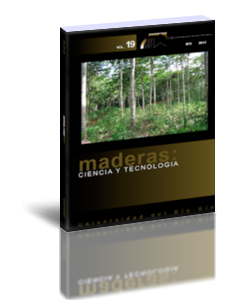A method to estimate wood surface moisture content during drying
Keywords:
Dry bulb temperature, equilibrium moisture content, fibre saturation point, moisture measurement, surface temperature, wet bulb temperature.Abstract
A method to estimate the surface moisture content below the fibre saturation point that is a function of the surface temperature, wet- and dry bulb temperatures, equilibrium moisture content, and fibre saturation point was evaluated. The method is based on the premise that the surface temperature is solely influenced by the surface moisture content and the climate that the surface is exposed to. The prediction model contends that the surface moisture content is equal to the fibre saturation point when the surface temperature is equal to the wet bulb temperature, and equal to the equilibrium moisture content when the surface temperature is equal to the dry bulb temperature, with a linear interpolation between those two points. The model thus predicts that the average moisture content of a thin piece of veneer can be predicted with fairly good accuracy. Also, when drying boards in a fast changing climate, e.g. fan reversals in industrial kilns, the surface temperature and surface moisture content should change as abruptly as the climate does. Additionally, the surface moisture content should correlate to the known drying phases, with a consistently high surface moisture content during the capillary phase when the wet line is close to the surface, and a quickly decreasing surface moisture content when the wet line moves into the wood during the transition to the diffusion phase. The prediction model was tested in these three scenarios and the results suggest that the basic premise is reasonable, and that the method is useful for surface moisture content estimation.Downloads
References
Baettig, R.; Rémond, R.; Perré, P. 2006. Measuring moisture content profiles in a board during drying: a polychromatic X-ray system interfaced with a vacuum/pressure laboratory kiln. Wood Science and Technology 40(4):261-274.
Rémond, R.; Perré, P.; Mougel, E. 2005. Using the concept of thin dry layer to explain the evolution of thickness, temperature, and moisture content during convective drying of Norway spruce boards. Drying technology 23(1-2):249-271.
Rosenkilde, A.; Glover, P. 2002. High resolution measurement of the surface layer moisture content during drying of wood using a novel magnetic resonance imaging technique. Holzforschung 56(3):312-317.
Scheepers, G.; Morén, T.; Rypstra, T. 2007. Liquid water flow in Pinus radiata during drying. Holz als Roh-und Werkstoff 65(4):275-283.
Stamm, A.J. 1967. Diffusion. Wood Science and Technology 1(3):205-230.
Watanabe, K.; Kobayashi, I.; Saito, S.; Kuroda, N.; Noshiro, S. 2013. Nondestructive evaluation of drying stress level on wood surface using near-infrared spectroscopy. Wood science and technology 47(2):299-315.
Watanabe, K.; Mansfield, S. D.; Avramidis, S. 2011. Application of near-infrared spectroscopy for moisture-based sorting of green hem-fir timber. Journal of wood science 57(4):288-294.
Wiberg, P.; Morén, T.J. 1999. Moisture flux determination in wood during drying above fibre saturation point using CT-scanning and digital image processing. European Journal of Wood and Wood Products 57(2):137-144.
Yamamoto, H.; Sakagami, H.; Kijidani, Y.; Matsumura, J. 2013. Dependence of microcrack behavior in wood on moisture content during drying. Advances in Materials Science and Engineering 2013: Article ID 802639, 7p.

































